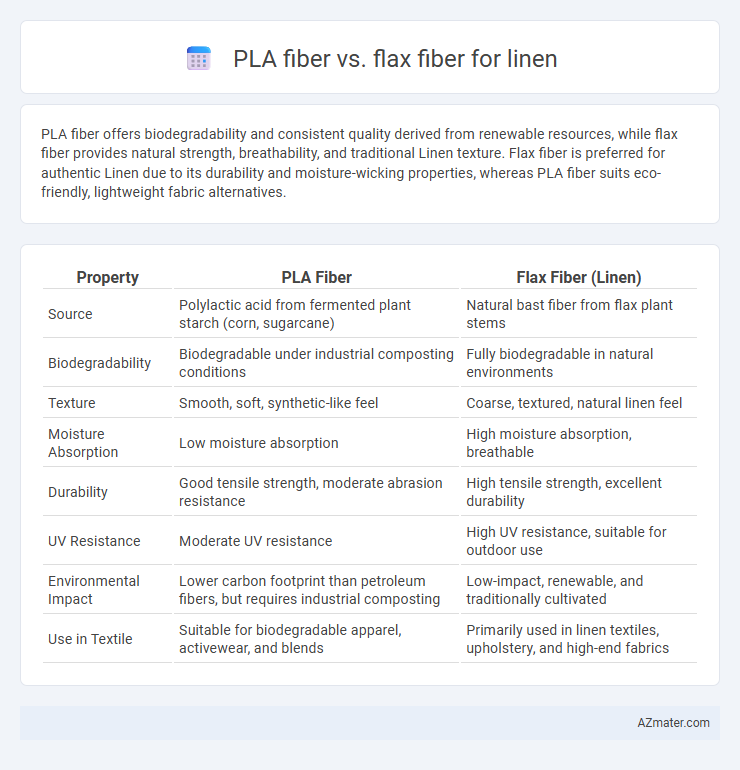PLA fiber offers biodegradability and consistent quality derived from renewable resources, while flax fiber provides natural strength, breathability, and traditional Linen texture. Flax fiber is preferred for authentic Linen due to its durability and moisture-wicking properties, whereas PLA fiber suits eco-friendly, lightweight fabric alternatives.
Table of Comparison
| Property | PLA Fiber | Flax Fiber (Linen) |
|---|---|---|
| Source | Polylactic acid from fermented plant starch (corn, sugarcane) | Natural bast fiber from flax plant stems |
| Biodegradability | Biodegradable under industrial composting conditions | Fully biodegradable in natural environments |
| Texture | Smooth, soft, synthetic-like feel | Coarse, textured, natural linen feel |
| Moisture Absorption | Low moisture absorption | High moisture absorption, breathable |
| Durability | Good tensile strength, moderate abrasion resistance | High tensile strength, excellent durability |
| UV Resistance | Moderate UV resistance | High UV resistance, suitable for outdoor use |
| Environmental Impact | Lower carbon footprint than petroleum fibers, but requires industrial composting | Low-impact, renewable, and traditionally cultivated |
| Use in Textile | Suitable for biodegradable apparel, activewear, and blends | Primarily used in linen textiles, upholstery, and high-end fabrics |
Introduction to PLA Fiber and Flax Fiber
PLA fiber, derived from renewable resources like cornstarch, offers biodegradable and eco-friendly properties that make it an innovative alternative in textile production. Flax fiber, extracted from the flax plant, is renowned for its durability, breathability, and natural luster, forming the traditional basis of high-quality linen fabric. Both fibers contribute to sustainable textile solutions, with PLA fiber representing modern bio-based innovation and flax fiber embodying natural heritage in linen manufacturing.
Origins and Production Processes
PLA fiber originates from renewable resources like cornstarch or sugarcane through a fermentation process followed by polymerization, resulting in a biodegradable thermoplastic fiber. Flax fiber is derived from the flax plant through retting, scutching, and hackling processes to extract long, strong fibers suitable for linen production. The industrial manufacturing of PLA involves controlled chemical synthesis and extrusion, whereas flax processing relies heavily on traditional agricultural and mechanical methods for fiber extraction.
Fiber Structure and Composition
PLA fiber, derived from polylactic acid, features a smooth, circular cross-section and a semi-crystalline structure, resulting in high tensile strength and moisture resistance. Flax fiber, a natural bast fiber, exhibits a polygonal cross-section with longitudinal fibrils and a high cellulose content, providing excellent breathability and natural luster for linen. The chemical composition of flax includes approximately 70-80% cellulose, lignin, and hemicellulose, whereas PLA is a synthetic polyester made from renewable resources, influencing durability and biodegradability.
Environmental Impact and Sustainability
PLA fiber, derived from renewable resources such as corn starch, offers biodegradability under industrial composting conditions, reducing landfill waste and greenhouse gas emissions compared to synthetic fibers. Flax fiber, cultivated with minimal pesticide use and low water consumption, boasts a carbon-negative footprint through its CO2 absorption during growth, making it highly sustainable for linen production. While PLA fiber depends on agricultural inputs and industrial processing energy, flax fiber integrates naturally into ecosystems, promoting soil health and circularity in textile sustainability.
Physical Properties Comparison
PLA fiber exhibits higher tensile strength and greater elasticity compared to flax fiber, making it more resistant to stretching and deformation. Flax fiber has superior moisture absorption and breathability due to its natural cellulose content, enhancing comfort in linen fabrics. Flax also offers better thermal insulation and durability under repeated washing, while PLA fibers provide enhanced biodegradability and UV resistance.
Comfort and Breathability in Linen Applications
PLA fiber offers moderate moisture-wicking properties, but flax fiber excels in breathability and natural moisture absorption, making it more comfortable for linen applications. Flax fibers have a unique hollow structure that enhances air circulation, resulting in superior thermal regulation compared to PLA. The softness and natural texture of flax also contribute to a more comfortable, skin-friendly fabric than the slightly synthetic feel of PLA.
Durability and Longevity
PLA fiber exhibits moderate durability with resistance to moisture and mildew but tends to degrade faster under prolonged UV exposure, limiting its longevity compared to natural fibers. Flax fiber, used in traditional linen, offers superior strength and durability due to its natural cellulose structure, ensuring enhanced wear resistance and extended lifespan. The natural breathability and toughness of flax fibers contribute to linen fabrics that maintain structural integrity over decades, outlasting PLA-based textiles in long-term applications.
Biodegradability and End-of-Life Options
PLA fiber, derived from renewable resources like corn starch, offers compostability under industrial conditions but biodegrades slower in natural environments compared to flax fiber. Flax fiber, a natural bast fiber, exhibits superior biodegradability, breaking down efficiently in soil and water without leaving harmful residues. End-of-life options for flax fiber include traditional composting and recycling, whereas PLA fiber requires specific industrial composting facilities to ensure complete degradation.
Cost and Market Availability
PLA fiber offers a cost advantage over flax fiber due to its bio-based but industrially scalable production, resulting in more consistent pricing and wider availability in textile markets. Flax fiber, used traditionally for linen, tends to have higher costs driven by labor-intensive cultivation and limited regional production, restricting its market supply. The growing demand for sustainable materials is expanding PLA fiber accessibility, while flax fiber remains a niche option valued for natural fiber quality but with less market penetration.
Choosing the Right Fiber for Linen Products
PLA fiber offers sustainability through biodegradability and a lower carbon footprint, making it an innovative choice for eco-friendly linen products. Flax fiber, the traditional source of linen, provides superior breathability, durability, and natural moisture-wicking properties essential for high-quality textiles. Selecting the right fiber depends on balancing environmental impact with performance characteristics to meet specific linen product requirements.

Infographic: PLA fiber vs Flax fiber for Linen
 azmater.com
azmater.com